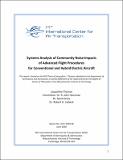Systems Analysis of Community Noise Impacts of Advanced Flight Procedures for Conventional and Hybrid Electric Aircraft
Author(s)
Thomas, Jacqueline
DownloadICAT-2020-06_Jacqueline Thomas PhD Thesis ICAT Copy_e-1.pdf (6.452Mb)
Metadata
Show full item recordAbstract
Recent changes to aircraft approach and departure procedures enabled by more precise
navigation technologies have created noise concentration problems for communities beneath
flight tracks. There may be opportunities to reduce community noise impacts under these
concentrated flight tracks through advanced operational approach and departure procedures
and advanced aircraft technologies. A modeling method to assess their impacts must consider
the contributions of aircraft engine and airframe noise sources as they vary with the position,
thrust, velocity, and configuration of the aircraft during the flight procedure. The objective is
to develop an analysis method to design, model, and assess the community noise reduction
possibilities of advanced operational flight procedures performed by conventional aircraft and
advanced procedures enabled by future aircraft concepts.
An integrated analysis framework is developed that combines flight dynamics and noise
source models to determine the community noise impacts of aircraft performing advanced
operational approach and departure procedures. Aircraft noise due to the airframe and engine
is modeled using an aircraft source noise module as each noise component varies throughout
the flight procedure and requires internal engine performance states, the flight profile, and
aircraft geometry. An aircraft performance module is used to obtain engine internal
performance states and aircraft flight performance given the aircraft technology level. A force-
balance-kinematics flight profile generation module converts the flight procedure definition
into altitude, position, velocity, configuration, and thrust profiles given flight performance on
a segment-by-segment basis. The system generates single-event surface noise grids that are
combined with population census data to estimate population noise exposure for a given
aircraft technology level and procedure.
The framework was demonstrated for both advanced approach and departure
procedures and advanced aircraft technologies. The advanced procedure concepts include
modified speed and thrust departures as well as continuous descent, steep, and delayed
deceleration approaches for conventional aircraft. The ability to model advanced aircraft
technologies was demonstrated in the evaluation of using windmilling drag by hybrid electric
aircraft on approach to allow the performance of steep and delayed deceleration approaches
for noise reduction beyond the performance capability of standard gas-turbine aircraft.
Date issued
2020-06-26Series/Report no.
;ICAT-2020-06